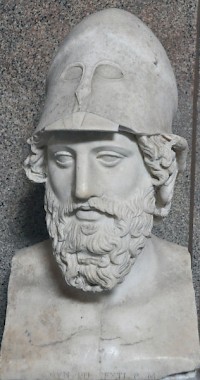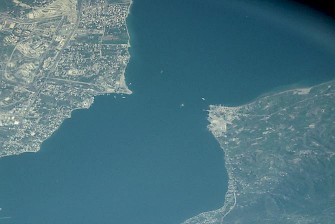Phormio
Phormio: one of the most important Athenian commanders during the first phase of the Peloponnesian War (431-404), the Archidamian War (431-421).

Our main source for the career of Phormio, the son of an influential Athenian named Asopius, is the History of the Peloponnesian War by the Athenian historian Thucydides. In the chapter known as Pentecontaetia ("the fifty years", between the Persian War and the Peloponnesian War) he mentions Phormio's first command: together with two men named Thucydides and Hagnon, he brought forty ships to Samos, which was besieged by Pericles in 440/439.
His second recorded command must have been in the early 430s. In the far west of Greece was the Gulf of Ambracia, which was surrounded by three states. In the north was the city of Ambracia (modern Arta), to the east was the city of Amphilochian Argos, and to the south was Acarnania. At an unknown moment, the Ambraciots had captured Amphilochian Argos, and its inhabitants had called for help from the Acarnanians and the Athenians. Phormio was sent to the west with thirty ships, took Argos by storm, sold the Ambraciots as slaves, and gave the city to its original inhabitants, who joined Acarnania. Phormio also concluded an alliance with the Acarnanians.
This brought the Athenians into the backyard of Corinth, and they continued this policy in 433, when they allied themselves to Corcyra (modern Corfu). The Corinthians and Athenians were now on very bad terms, and this caused the next conflict: Potidaea, a city on the isthmus of the westernmost of the three peninsulae of the Chalkidike.
The town belonged to the Delian League of Athens, but had been founded by settlers from Corinth and traditionally received officials from its mother town. In 432, the Athenians demanded that Potideia would expel its Corinthian magistrates. The dispute escalated and the Athenians sent an army that started to besiege Potideia from the north. To this was later added a second army, commanded by Phormio, who approached the town from the south. (During this campaign, Socrates saved the life of Alcibiades.)
The siege was still going on when Corinth persuaded Sparta to declare war: the Archidamian War had started (March 431). During the first year of this conflict, the Athenians were on good terms with the Macedonian king Perdiccas, who collaborated with Phormio in the winter of 431/430. Still, the siege continued and it appears that early in 430, Phormio's army was recalled. His successor was Hagnon, who could not take the city either, because he had the bad luck of having to suffer from the Plague. However, in the winter of 430/429, Potideia finally came to terms.

Meanwhile, it had become clear that a substantial part of the war was to be fought in the west, where Corinth wanted to restore order in its backyard. This was not in Sparta's interest, but as it needed Corinthian naval support, it had to support its ally. The Athenians knew what was happening and decided to cut off the lines between Corinth and the Athenian allies, so in the winter of 430/429, they sent Phormio to Naupactus, an Athenian base at the entrance of the Corinthian Gulf. He commanded twenty ships, and was able to overcome his enemies - commanded by Cnemus and Brasidas - in two naval battles near Rhion and Antirhion, even though he was heavily outnumbered (text). But the Corinthian and Spartan forces were no match for the experienced Athenian rowers.
In the winter of 429/428, Phormio brought help to the Acarnanians. He expelled several people who were regarded as being unreliable, and returned to Naupactus again. In the spring, he sailed back to Athens, and retired.
Phormio had made a good impression upon the Acarnanians, because they requested that his successor in Naupactus would be his son Asopius. He was killed in action when he attempted to take the Acarnanian town Oeniadae.
The Athenians remembered Phormio fondly. Pausanias records a story that once, he was unable to pay a debt, so his fellow citizens paid the money. It was remembered that he had lived in Paeania, a country town east of Athens. When he died, he received a state burial near the tombs of Pericles and Thrasybulus, and the Athenians erected his statue on the Acropolis. The tomb and the statue were still visible in the second century CE, almost six centuries after his death.